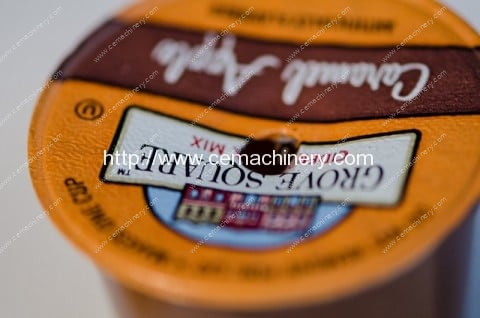Why I Kicked My Keurig to the Curb
What busy person doesn’t love the idea of having a personal cup of coffee instantly with the push of a button. Many people are delighted when the Keurig machines show up in the workplace or doctor’s waiting room. I loved the idea. I bought one from Costco along with the handy unit to store those awkward K Cups. I, of course, insisted on the Newman’s Organic K Cups for my coffee choice.
We stocked our hot beverage center with a variety of flavored K Cups.
Table of Contents
Then That Little Voice in My Head Started Asking Questions
I pushed those concerns away for the sake of convenience (after all, filling my own coffee filter with fresh ground coffee takes all of what … two minutes? I’m a busy person, just like you!).
I wondered:
- How fresh is the coffee in a K Cup?
- What toxins am I exposing myself to as the hot water forces the coffee through the little holes poked in the plastic cup?
- What is that lid made of that is poked at the top to allow the water to enter the cup?
- What chemicals are used in the flavored coffee selections?
- Is there a filter inside the plastic cup? What is it made of and how is it secured inside the plastic cup?
If you own a Keurig, please continue reading this post because what I discovered is shocking and sickening. This will explain why I am kicking my Keurig to the curb.
Is Your Keurig Harboring Mold and Bacteria?
When I packed up my kitchen to move 500 miles south, I wanted to make sure that my Keurig was completely empty and dry before it went on the moving truck. IMPOSSIBLE!
Keurig.com states, “Once your Keurig home brewer has been primed, you cannot empty the water from the inside. The internal tank of the brewer cannot be drained.”
The microbiologist in me is disgusted at the thought. Back in the day when I worked in a hospital lab, we emptied all water reservoirs daily or they would grow bacteria and a biofilm could develop. You are familiar with biofilms if you ever cleaned the goo out of a flower vase after the flowers have died. Biofilms are found wherever there is water and a surface to stick to (like your shower curtain).
The rubber tubing and the internal tank of the Keurig cannot be drained. It is possible that bacteria and mold are happily living inside that hidden water tank where it is nice, dark, and warm. Another mold-magnet is that black rubber ring on the bottom of the exterior water container. Look now! Is there green or black slime? Ewwwww (biofilm!).
Donna Duberg, M.A., M.S., an assistant professor of clinical laboratory science at Saint Louis University said, “Bacteria forms a slick biofilm when grown in moist, dark places, and so do molds.”
No, your coffee bean’s antibacterial action is not enough to kill these microbes that are floating through the system. Duberg said, “There is research which shows that it is only about 50 percent effective in killing bacteria, such as Staphylococcus aureus and Streptococcus mutans, and molds.”
No, your water is not getting hot enough to kill all microbes that are living in your coffee system. For that to happen, the water would need to reach boiling temperature and stay there for one minute. And, for heaven’s sake, wash your workplace coffee mug with dish soap and water. Researchers found that half of workplace coffee mugs were contaminated with fecal bacteria.
Can you clean the Keurig? The first step is to empty out the exterior water tank and look inside the tank. Does it feel slimy? Clean and dry that tank and run a few cycles of diluted vinegar through the Keurig. Good luck with that. One person said, “I could still smell a moldy aroma after doing quite a few vinegar cycles. There were also black, floaty things in my cup even when I just brewed hot water.”
Plastic K Cups Conundrum
The Plastic – The K Cup is a composite plastic, #7. Although this is technically BPA-free, the chemicals from the composite plastic are not safe and they still have estrogenic activity. As long as I mentioned fake estrogens coming from the plastic in your K Cup, don’t make a bad situation worse by adding soy milk to your coffee! (Men, would you like “moobs” with your mocha and soy?).
The Cups Are Non-Recyclable – This is a big problem for the environment since we have seen an explosion in the use of single cup coffee makers, like Keurig, in the last few years. MotherJones.com reported, over 8.3 billion K Cups a year are discarded, enough to circle the earth 10.5 times!
The Lid is Polyethylene Coated Foil
Aluminum foil. Yes, we would like to avoid aluminum because of the connection with the biggies:
Dr. Stephanie Seneff, PhD recently gave a talk, “How aluminum and glyphosate (Roundup) collaborate to cause anxiety, depression, autism and celiac disease” you can still get MP3s and transcripts if you are interested.
The Filter – The filter is made of filter paper and ? – I don’t know but somehow it is fused or glued inside the plastic cup.
Reusable K Cups – Although there are reusable K Cups called My K-Cup on the market, you are still faced with the stagnant water situation and hidden water tanks and tubing that cannot be cleaned. The reusable My K Cup still needs to be filled every time you make a cup of coffee and the filter needs to be cleaned every time. There goes your convenience, but if you are willing to risk the microbes, then this is better for the environment and more economical.
The Coffee – The flavored coffee K cups are typically flavored with “natural” or artificial flavors. We know that food manufacturers use these names to hide ingredients that act like MSG, a neurotoxin. I help people get to the root cause of chronic migraines and headaches. Often these MSG flavors are causing the problem.
One Keurig K cup user complained of nausea, fatigue, dizziness and vomiting. “This all started when my work got a Keurig machine and I started drinking their tea regularly.”
Another user reported, “I have noticed when I use the K Cups on a daily basis, my lips tend to get dry and numb on the outside.”
One of my clients noticed a connection between skin rashes and the use of the Keurig K cups with flavoring.
Well, Do You?
Do you care about the taste and quality of your coffee?
Do you care about the environment and the workers in the coffee bean industry?
Do you care about your health?
There is nothing like a steaming hot cup of freshly brewed coffee made with quality coffee beans. Using the Keurig was easy, but the taste was marginal. I do not consider myself a coffee connoisseur, but I love a good cup of coffee. Finally, I allowed myself to consider all the issues with the Keurig and I decided to kick my Keurig to the curb.
Now That’s a Good Cup of Coffee
The coffee beans you purchase should look inky black and ideally they are Fair Trade, organic and shade grown.
The coffee beans should have been grown and processed without the use of pesticides, herbicide or chemicals. “Most people are not aware that regular coffee consumption can be a significant source of pesticides. According to the CS Monitor, conventional farmers apply up to 250 pounds of chemical fertilizers per acre!” – Mercola.com
Are you sipping pesticides with your brew?
We know that pesticides are contributing to the growing rate of cancer, Parkinson’s Disease and miscarriage.
Use non-bleached filters. White filters have been bleached with chlorinated bleach.
Shade grown coffee is better tasting coffee because shade-coffee beans ripen more slowly, resulting in a richer flavor. More importantly it is better for the environment and provides a healthier environment for the workers.
When shopping look for Organic, fair trade, shade grown beans. Get a grinder and grind at home. Brew using spring water.
French Press Coffee Raises Triglycerides
Many people consider the French Press to be the ultimate coffee brewing method. Coarse ground coffee is allowed to steep for several minutes in boiling water in the French Press. The result is a richer, fuller flavor with more aroma and a more delightful coffee experience. It is interesting to note that French Press coffee is higher in cafestol, a fraction of coffee that has been shown in studies to raise triglycerides and LDL cholesterol. Using a non-bleached coffee filter with a coffee maker will remove the cafestol. Here is a link to one of the 15 studies found on PubMed.gov.
Is Coffee Healthy?
For the general population the evidence from several large studies suggests that moderate coffee drinking is not detrimental to health and may have several health benefits. If coffee gives you the shakes, disturbs sleep, and increases stress, then cut back or eliminate coffee. It is never healthy to drink pesticides in coffee. It is never healthy to have an increased exposure to estrogenic compounds from plastic K Cups. It is never healthy to continue to make coffee with any machine that is harboring mold and bacteria.
Stop Drinking Froo Froo Coffee Drinks
The cafe on the corner may be serving up delicious coffee drinks, but take the time to look up the ingredients and calorie content of your favorite drink. Many contain artificial flavors (MSG), high fructose corn syrup, caramel color and preservatives. Here are some examples of Froo Froo Drinks to avoid:
- Starbucks Frappuccino – The Java Chip Frappuccino is making you fat and sick! 460 calories for the biggie but worse than that it delivers 22.5 tsp of sugar to your blood stream (90g carbs). This amount of carbohydrate in liquid calories is a disaster for your blood sugar, and it will be too much for the body to handle effectively so the excess sugar will be sent to the liver where it is turned into F.A.T.
- Dunkin Donuts Coolatta – The Frozen Caramel Coffee Coolatta is making you fat and sick! 600 calories for the large mocha with skim milk. This little darling will deliver 36 tsp of sugar to your bloodstream (144g carbs) leaving you too full for your next meal but packing on the fat from the excess sugar.
Life is too short to drink bad coffee. Get the good beans, grind them fresh, brew it yourself. Be good to yourself. Be good to the earth.
Company Profile
Romiter Group is a market leading designer and a manufacturer of coffee capsule filling sealing machinery, include coffee capsule packing machine, coffee capsules filling sealing machine, nespresso capsules filling sealing machine, k-cup filling sealing machine, lavazza blue capsules filling sealing machine, coffee pod filling sealing machine, coffee pod packing machine, coffee bean roasting machine, coffee capsules carton box packing machine, manual coffee capsules sealing machine




